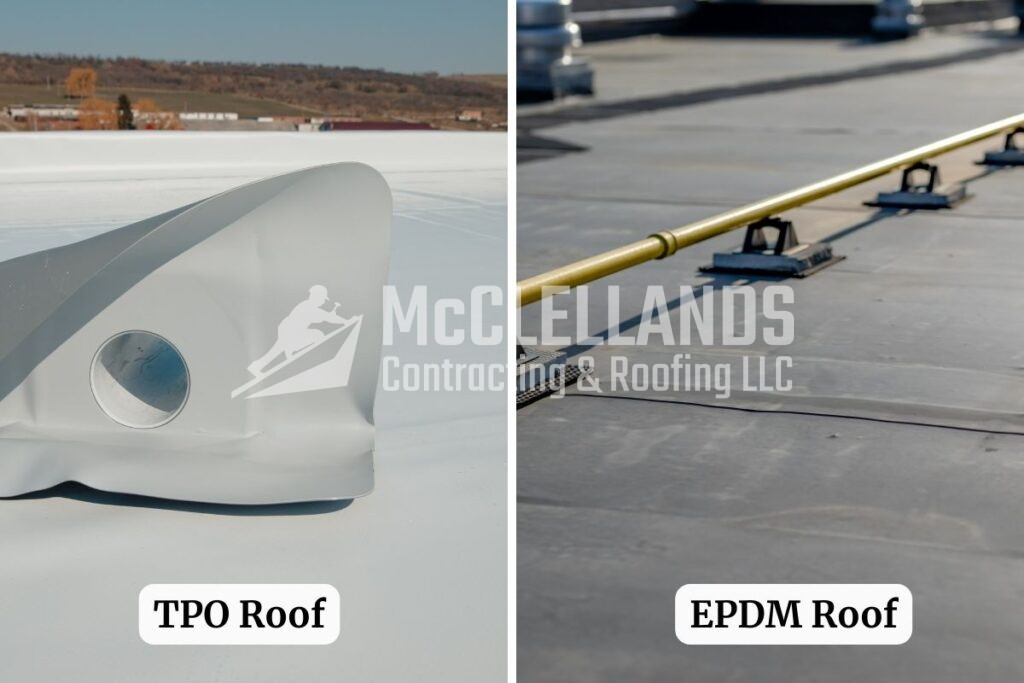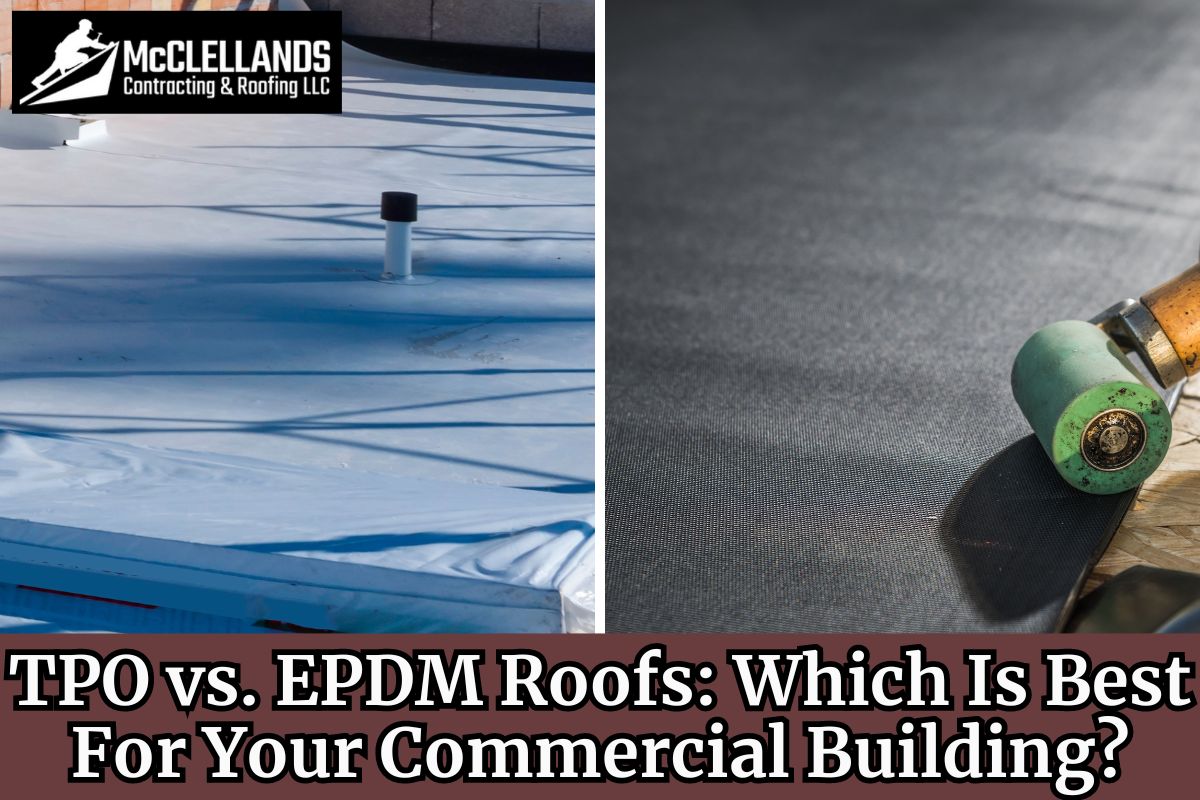There are many options available for a commercial roofing system, but two stand out as the most highly debated. These two materials are TPO and EPDM. Both commercial roofing materials are really popular, which means you’ll want to have a deeper understanding of these materials in order to choose the one that is right for your building.
At McClellands Contracting and Roofing, we always aim to guide homeowners through the options that are available to them for their buildings and roofs. In this blog post, we will discuss TPO roofs vs. EPDM roofs in closer detail to help you decide on the right one.
Note: The costs shared in this blog post is just an average estimate, and the exact cost can vary depending on other factors.
What Is A TPO Roof?
TPO is a modern, single-layer roofing material made of tough plastic called thermoplastic polyolefin, which creates a strong fabric layer that’s durable and resistant to damage. TPO roofs are great at keeping buildings dry and cool by reflecting sunlight, which in turn, lowers your need to use air conditioning.
What Is An EPDM Roof?
EPDM stands for Ethylene Propylene Diene Monomer, which is a special kind of synthetic rubber that is used for single-ply roofing membranes. This creates a strong waterproof layer that protects the underlying materials while offering enhanced flexibility without breaking, making it perfect for areas with temperature fluctuations. .
TPO vs. EPDM: A Detailed Comparison

In the chart below, we’ve compared TPO roofs vs. EPDM roofs in various different categories.
| TPO | EPDM | |
| Durability | Durable, but has a shorter lifespan than EPDM roofs lasting around 25 years | Very durable, can last 20 to 30 years, some up to 50 years |
| Composition | Made from thermoplastic polyolefin (a type of plastic) | Made from synthetic rubber |
| Cost | $4 to $12 per square foot installed | $4 to $10 per square foot installed |
| Energy Efficiency | Reflects sunlight, keeping buildings cooler and reducing air conditioning costs | Black color absorbs heat, which can increase cooling costs. White versions are available but less common |
| Installation | Needs special heat-welding equipment for installation | Easier to install and has many methods of sealing |
| Maintenance | Requires less maintenance once installed. | It may need more frequent checks and repairs, especially at the seams |
| Weather Resistance | Excellent resistance to UV rays and weather damage | Good overall, but can be damaged by hail or falling branches |
| Flexibility | Less flexible than EPDM but still performs well | Very flexible, good for handling temperature changes |
| Fire Resistance | Can resist fire | Can resist fire |
| Environmental Impact | Recyclable | Recyclable |
Which Roofing Material Is Best For Your Commercial Building?
Now, before choosing a roofing material from these two options, you need to understand the needs of your building and what it will require in order to be protected.
When To Choose An TPO Roof
#1 You Live In A Hot and Sunny Climate
If your building is in a place where the sun shines down on the roof most of the year, TPO is a great choice, since it acts as a large reflective shield. TPO bounces back the sun’s heat, keeping your building cooler.
#2 You Want To Save On Energy Bills
TPO really stands out when it comes to energy efficiency. If you’re looking to cut down on air conditioning costs, TPO can be a game-changer. Over time, it may even lead to significant savings on your energy bills.
#3 The Roof Has A Complex Design
Does your roof have lots of corners, pipes, or vents sticking out? TPO might be your best bet. Its heat-welded seams create a super strong, watertight seal, even around tricky spots.
#4 You’re Looking For A Long-Term Investment
While TPO might cost more upfront, its energy-saving features and durability can make it a smart long-term choice.
When To Choose An EPDM Roof
#1 The Roof Is Large
If your building has a big, flat roof, EPDM is a better choice since it’s perfect for covering large areas without a lot of fuss.
#2 Your Area Experiences Frequent Temperature Swings
Does your area go from super hot to freezing cold? EPDM is great at handling these temperature changes without cracking or splitting.
#3 Quick Or Flexible Installation Is Needed
If you’re in a hurry to get your roof done, or if you need a material that’s easier to work with in tight spaces, EPDM might be your answer. It’s often quicker to install than TPO.
#4 You Have Budget Concerns
EPDM comes in large rolls, which leads to a low cost per square foot. This makes it the more budget-friendly option upfront, so if you’re working with a tight budget, this could be a deciding factor in your material choice.
Remember, these are just general guidelines that you should consider. Every building is unique, and what works best for one might not be ideal for another. It’s always a good idea to talk to a roofing expert who can look at your specific situation.
Call McClellands Contracting and Roofing For Quality Roof Installations In Pittsburgh, PA
If you are looking for reliable roof installation and replacement services in Pittsburgh and the surrounding areas of Pennsylvania, then we are here to assist you. At McClellands Contracting and Roofing, we aim to serve property owners with quality roofing services.
We understand that the roof is an important investment, which is why our roofers will help you find the right material and ensure a flawless installation.
We are one of the best rated roofing contractors in Pennsylvania and our commitment to quality service is the reason behind that. We also offer financing options so that you don’t have to stress about paying for your next roofing project. Trust us as your reliable roofing contractor and we will make sure that you receive satisfactory results. To know more about our services, or for a custom quote, feel free to call us at (412) 353-5660.
FAQ
A.The weight that TPO and EPDM roofs can hold depends on several factors, including the structural support of the roof, the thickness of the roofing material, and local building codes. Generally, TPO is a lightweight roofing material, typically weighing between 0.40 to 0.60 pounds per square foot. Despite its lightweight nature, the weight it’s able to support largely depends on the underlying roofing structure. Typically, commercial roofs designed with proper structural support can handle additional loads such as HVAC units, walkways, and light foot traffic for maintenance purposes.
Similarly, EPDM is also lightweight, usually weighing around 0.50 to 0.75 pounds per square foot. The load-bearing capacity of an EPDM roof, like TPO, depends on the roof’s structural design, but is typically able to accommodate the same type of equipment if it’s supported correctly.

